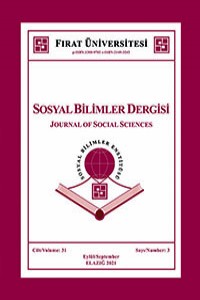Öz
Maximinus Thrax, Roma İmparatorluk tarihinde farklı özellikleriyle öne çıkan imparatorlarından biridir. Soylu bir aileden gelmediği gibi praetor praefectus makamına ulaşmış bir asker de değildir. Onun imparator olmasıyla beraber Severus ve Constantinus hanedanlıkları arasında askerlerin imparatorluk tahtına çıktığı bir dönem başlar. III. yüzyıl krizi olarak adlandırılan bu dönem, askeri kuvvetin ön plana çıktığı, devlet hazinesinin boşaldığı, imparatorluk sakinlerinin yoksullaştığı ve dış istilaların arttığı bir zayıflama sürecini temsil etmektedir. Maximinus Thrax, askeri disipline dayanan yönetimi, acımasız ve merhametsiz kişiliği sebebiyle uzun süre sonra ilk kez Tyrannus (Tiran) olarak görülen bir imparator olmuştur. İktidarını pekiştirmek, sıradan kökenini gizlemek ve konumunu güçlendirmek için Roma sakinlerini sert bir yönetime tabi tutmuştur. Askeri bir disiplin benimsemesine ve gücü elinde toplama çabasına rağmen askeri zaferleri oldukça azdır. İktidarının gönüllü olarak kabul edilmemesi nedeniyle halk ve senatus tarafından, imparatora karşı ayaklanmalar olmuştur. Fakat bu karşı girişimler şiddetli iç savaşlarla sonuçlanmıştır. Bu çalışmanın amacı, imparator Maximinus Thrax’ın hakimiyet dönemini ve imparatorluğu krize sürükleyen olayları ele almaktır.
Anahtar Kelimeler
Kaynakça
- Epitome De Caesaribus. (2018). A Booklet About The Style Of Life And The Manners Of The Imperatores. (Eng. Transl. Thomas M. Banchich). Canisius College Translated Texts 1. Canisius College.
- Eusebius. (1942). The Ecclesiastical History, English Translation J.E.L. Oulton, Harvard University Press, Vol. II.
- Herodianus. (1970). (Eng. Transl. C.R. Whittaker). Cambridge Massachusetts.
- Scriptores Historiae Augustae. (1932). (Eng. Transl. David Magie). Loeb Classical Library.
- Clarke, G.W. (1966). Some Victims of the Persecution of Maximinus Thrax. Historia: Zeitschrift für Alte Geschichte, 15 (4), 445-453.
- Daryaee, T. (2009). Sasanian Persia: The Rise and Fall of an Empire. London and New York: I.B. Tauris & Co.
- Drinkwater, J. (2008). Maximinus to Diocletian and The Crisis. A.K. Bowman-P. Garnsey-A. Cameron (Ed.), The Cambridge Ancient History-The Imperial Crisis and Recovery A.D. 193-324 içinde (28-67). Vol. XII. Cambridge: Cambridge University Press.
- Pearson, P.N. (2016). Maximinus Thrax: From Common Soldier to Emperor of Rome. Pen & Sword Military.
Öz
Maximinus Thrax is one of the prominent emperors with different features in the history of the Roman Empire. He is not from a noble family, nor is he a soldier who has reached the rank of praetorian prefect. With his becoming emperor, a period begins between the Severan and Constantinian dynasties, when soldiers ascend to the imperial throne. This period, which called the crisis of the 3rd century, represents a period of weakening in which military strength comes to the fore, the state treasury was emptied, the inhabitants of the empire became impoverished and foreign invasions increased. Maximinus Thrax became an emperor for the first time in a long time, seen as a tyrant, due to his military discipline-based rule and his ruthless and ruthless personality. He subjected the inhabitants of Rome to harsh rule in order to consolidate his power, hide his ordinary origin and strengthen his position. Despite adopting a military discipline and an effort to concentrate power, his military victories are very few. There were uprisings against the emperor by the people and the senate because his power was not voluntarily accepted. But these counter attempts resulted in violent civil wars. The aim of this study is to discuss the reign of Emperor Maximinus Thrax and the events that brought the empire into crisis.
Anahtar Kelimeler
Kaynakça
- Epitome De Caesaribus. (2018). A Booklet About The Style Of Life And The Manners Of The Imperatores. (Eng. Transl. Thomas M. Banchich). Canisius College Translated Texts 1. Canisius College.
- Eusebius. (1942). The Ecclesiastical History, English Translation J.E.L. Oulton, Harvard University Press, Vol. II.
- Herodianus. (1970). (Eng. Transl. C.R. Whittaker). Cambridge Massachusetts.
- Scriptores Historiae Augustae. (1932). (Eng. Transl. David Magie). Loeb Classical Library.
- Clarke, G.W. (1966). Some Victims of the Persecution of Maximinus Thrax. Historia: Zeitschrift für Alte Geschichte, 15 (4), 445-453.
- Daryaee, T. (2009). Sasanian Persia: The Rise and Fall of an Empire. London and New York: I.B. Tauris & Co.
- Drinkwater, J. (2008). Maximinus to Diocletian and The Crisis. A.K. Bowman-P. Garnsey-A. Cameron (Ed.), The Cambridge Ancient History-The Imperial Crisis and Recovery A.D. 193-324 içinde (28-67). Vol. XII. Cambridge: Cambridge University Press.
- Pearson, P.N. (2016). Maximinus Thrax: From Common Soldier to Emperor of Rome. Pen & Sword Military.
Ayrıntılar
| Birincil Dil | Türkçe |
|---|---|
| Bölüm | Tarih |
| Yazarlar | |
| Yayımlanma Tarihi | 16 Eylül 2021 |
| Gönderilme Tarihi | 5 Temmuz 2021 |
| Yayımlandığı Sayı | Yıl 2021 Cilt: 31 Sayı: 3 |

